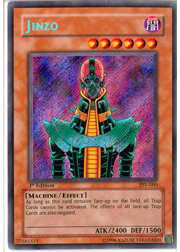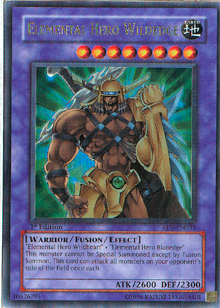The damage step is divided up into a sequence of events, several of which begin brief chains similar to what we saw in the battle step. All of this usually flows in a fairly fluid manner and will only be hindered by the accumulation of card effects introduced by both players. Many effects will activate in the damage step, but they won’t do it at the same time.
Meeting Your Opponent
The first event of the damage step involves flipping the attacked face-down monster (if any) and the basic "start" of the damage step. This period is normally referred to as "the start of the damage step" or "before damage calculation." This section of the damage step is a bit uneventful, so whatever happens depends entirely upon attacking a face-down monster or the existence of related card effects.
Without the inclusion of any card effects, this section of the damage step will only matter if a face-down monster is attacked. At this time the face-down monster is flipped face up and we see who we have elected to attack. If this face-down monster has a flip effect or a trigger effect that activates when the monster is flipped, the effect is not yet activated. It is saved for later, during its own special section of the damage step.
Monsters with stated flip effects are fairly easy to spot. Monsters with trigger effects that activate because they’ve been flipped face up are a bit trickier. Royal Keeper, at one time, became the subject of scrutiny for this very reason. Players read its effect and assumed its ATK and DEF increase would be applied at the time it was flipped by the attack, but this effect is a trigger effect resulting from the monster being flipped, so it has to wait until after damage calculation.
 Continuous effects, on the other hand, will be applied when the face-down monster is flipped face up. Nightmare Penguin has a trigger effect that activates when it is flipped face up that does not immediately activate when it is flipped by an attack. It also has a continuous effect that increases the ATK of Water monsters on its side of the field, and this effect is applied at the time it is flipped face up by the attack. This continuous effect doesn’t mean much for a defense-position Nightmare Penguin. A Jinzo, however, would begin negating trap cards when flipped by the attack, which can interfere with cards that might have been used during the battle.
Continuous effects, on the other hand, will be applied when the face-down monster is flipped face up. Nightmare Penguin has a trigger effect that activates when it is flipped face up that does not immediately activate when it is flipped by an attack. It also has a continuous effect that increases the ATK of Water monsters on its side of the field, and this effect is applied at the time it is flipped face up by the attack. This continuous effect doesn’t mean much for a defense-position Nightmare Penguin. A Jinzo, however, would begin negating trap cards when flipped by the attack, which can interfere with cards that might have been used during the battle.
We don’t see a great deal of effects activating in this section of the damage step, although there are a few that stand out. Reflect Bounder calls this section of the damage step home, and will activate its effect if it is attacked while in face-up attack position. Monsters like Kiseitai and Blast Sphere will activate their effects if they are attacked while face down, equipping themselves onto the attacking monster. Sasuke Samurai and Drillroid also call this section home, although they don’t exactly agree on when they should use their effect. Sasuke Samurai and Mystic Swordsman LV2 use their effect without flipping the face-down monster face up, "severing" the monster without caring who it is or what it may have done. Drillroid actually flips the monster face up and then destroys it. The effect is similar, but with Drillroid, the flip effect of the destroyed monster may still activate. Some monsters like Disc Fighter and trap cards like Cross Counter must wait until after the monster is flipped to determine whether or not they should be applied, because their effect is based on specific ATK/DEF values.
Steamroid fits into another category, because its continuous effect is applied as soon as the damage step begins. It doesn’t even start a chain, because continuous effects never "activate." This really only matters when you attack something like
Reflect Bounder, because otherwise you won’t care until you reach the next event: damage calculation.
Smash You!
With the initial prep work out of the way, we enter the main event. Damage calculation is actually divided up into separate events, and effects will selectively choose when to activate according to their own specific requirements.
You begin with the damage calculation itself. Effects that activate "during damage calculation" will start a chain at this time. They only get this one chain, and when it is resolved, the damage (if any) is calculated and inflicted to the appropriate player. This damage step event involves a variety of effects. Continuous, trigger, and multi-trigger effects can all apply at this time. The effects that apply to this event normally involve altering the ATK and/or DEF of a monster, because there isn’t much else going on here.
If the battling monsters have triggered effects, their effects will start the chain. These trigger effects normally activate based on specific details of the battle. Whether it’s based on a monster’s attribute, type, or battle position is entirely up to the monsters involved. Sometimes these effects are actually continuous effects and it can be difficult to know which is which from the text alone. In uncertain cases, we will usually refer to the card rulings or use our best judgment.
Injection Fairy Lily, Luminous Soldier, Kinetic Soldier, Kuriboh, the Gate Guardian monsters, Skyscraper, and Metalmorph will all find reason to use their effects at this time. This is essentially the last chance to activate effects that will alter the ATK/DEF of a monster, because damage is applied when this chain resolves.
Example 1: The Hero Always Wins!
 Jaden has Skyscraper active in his field spell card zone. He has Elemental Hero Wildedge in face-up attack position. His opponent Kenyou has Kinetic Soldier in face-up attack position. Jaden declares an attack with Wildedge against Kenyou’s Soldier.
Jaden has Skyscraper active in his field spell card zone. He has Elemental Hero Wildedge in face-up attack position. His opponent Kenyou has Kinetic Soldier in face-up attack position. Jaden declares an attack with Wildedge against Kenyou’s Soldier.